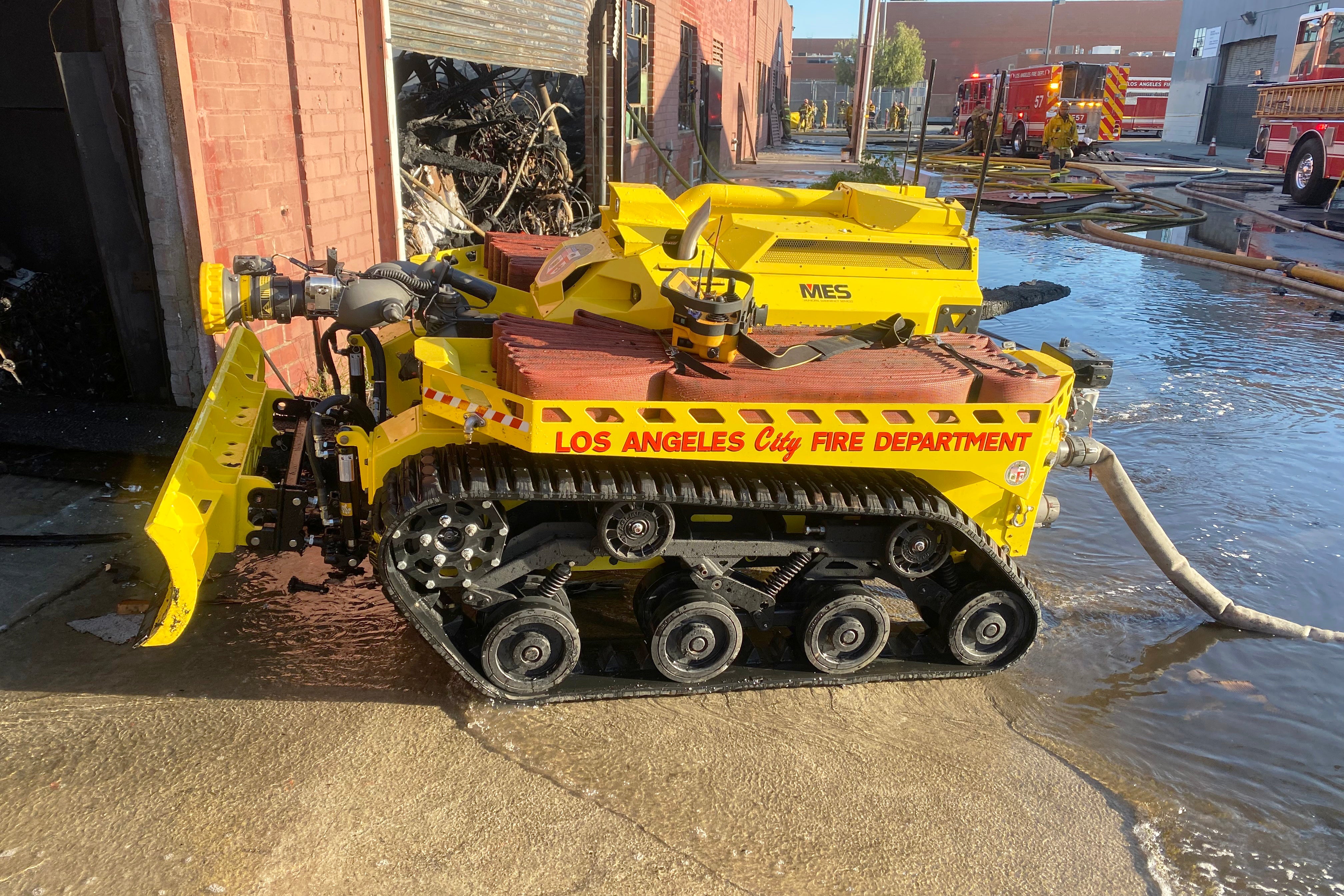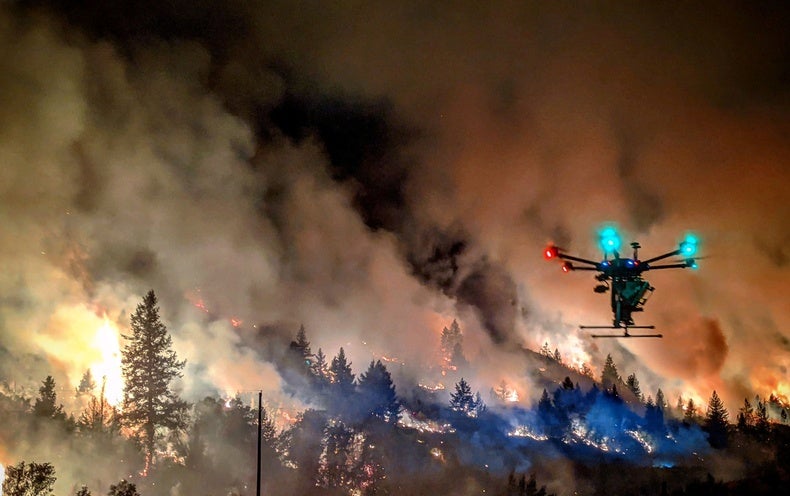Firefighting, one of the nation’s most tradition-bound professions, is poised for an influx of eccentric assistants. They range from contraptions the size of a toy wagon to two-ton beasts that resemble military tanks and can blast out 2,500 gallons of water per minute. Some move on rubber tires, some on steel tracks, and some fly. All are robots.
At a time when more than 3,000 Americans die in fires each year—including an average of 80 firefighters—these high-tech devices can enter burning buildings too hot for human survival. They can penetrate smoke too toxic for human lungs. They are often faster, stronger and more agile than the firefighters they work with. Most of the machines currently in use are remote-controlled, but researchers are now developing “intelligent” firefighting robots that can make decisions autonomously.
Autonomous or not, no one expects machines to completely replace humans on the fire line. Robots are tools, explains Giuseppe Loianno, a research scientist and assistant professor at New York University—and one valuable thing they can do is reduce risks to human firefighters. With more than 350,000 American homes burning annually, and climate change contributing to 10,000 active daily wildfires worldwide, robots can offer some respite to firefighters entering blazing buildings or traversing steep mountainsides. The main challenge these machines face is institutional reluctance to invest in devices tailored to meet these varying niche needs. “This is not a technological problem. It’s more of a socioeconomic problem,” says Neil Sahota, an inventor who advises the United Nations on artificial intelligence issues.
Researchers are working to change this. One of the most affordable automatons developed thus far was built by a group of university students using widely available off-the-shelf materials. An unassuming machine resembling a teched-out, canary yellow go-cart, it carries a water tank and a shoebox-size PC; the latter uses information from onboard sensors to move around without crashing into obstacles. A skinny arm protrudes above the chassis and can bend in several places, including an upper “elbow” that twists into angles beyond what a human limb could tolerate. The arm is tipped with a heat-sensing camera, another camera that measures depth and color, and a nozzle. In a recent demonstration this robot pauses in a doorway to get its geospatial bearings, then rolls smoothly into position to assess the room. The tip of the arm rotates, scanning the walls in search of a heat source. When it finds one, it aims the nozzle and opens up, spraying water in a grid pattern precisely over the hotspot. The fire out, the robot pauses in a puddle as if taking a ceremonial bow. It recently won the 2020 Mohamed Bin Zayed International Robotics Challenge.
What makes this working-class cousin to R2-D2 unique is the way its student designers combined hardware components with software intelligence, says Loianno, who coordinated the project. The students demonstrated that an autonomous firefighter can be built for around $40,000 to $50,000—even as little as $10,000—by using less-expensive components, Loianno adds. That’s 30 times cheaper than the cost of some firefighting bots currently in use.

This autonomous bot has yet to be tested in a real-world fire, however. Mobility is the big complication, says Sahota, who was not involved in the student collaboration. It is possible to program a robot to manipulate stairwells or even do backflips, Sahota notes. But adapting an autonomous robot for unexpected and uneven terrains remains daunting, he says.
A human-controlled robot called Robotics Systems 3 (RS3), now in use by the Los Angeles City Fire Department, has met some of these real-world mobility challenges and proved useful by dragging hose lines up steep hills and even pulling horses out of mud quagmires, says LAFD Assistant Chief Wade White. The $300,000 RS3, American-made and funded through the fire department’s foundation, has also worked with firefighters in buildings with collapsing roofs—“places where we could potentially lose a human life,” White says.
At 3,500 pounds with a massive yellow plow nose, tanklike treads and a nozzle that can blast water at 10 times the rate of a conventional fire hose, the RS3 is certainly less vulnerable than its human coworkers—but it still relies on one of them to control it. From a safe distance of 900 feet, operators can view video and temperature information from four cameras that monitor the robot’s surroundings. One camera, mounted on the nozzle, shows where the water spray is directed. Another uses thermal imaging to help an operator find any potential victims. Unlike the case with the students’ autonomous device, the people running RS3 and other human-operated robots “are processing all this information and making decisions based on … input” from the devices, White says. That distinguishes RS3 and other human-operated robots from the students’ project. “It will never replace firefighters,” White says. Instead, it is a tool that allows humans to choose effective strategies without risking their lives.
Faced with steadily worsening wildfires in the American West, the U.S. Forest Service has been dabbling with remote-controlled firefighting technologies since the early 2000s. Its program began in earnest in 2018, driven by four firefighter-carrying helicopter crashes since 2010. “That’s 16 fatalities in eight years,” says Dirk Giles, manager of the agency’s Unmanned Aircraft Systems program. “We needed to deploy technologies to get our employees out of that dead man’s curve.” After flying observational drones for several years to gather information about fire conditions, the agency added “dragon eggs” to its arsenal. Remote-controlled aircraft drop spheres the size of ping-pong balls, filled with two compounds: potassium permanganate and glycol. They descend through the canopy to the ground, where the chemicals react to start small and deliberate fires. These controlled burns aim to return fire to its natural role in the landscape, where it helps keep forest fuels at more balanced levels. Since the program started, the Forest Service has used dragon eggs to start about 200,000 acres of intentional burns.
This past summer, the agency adapted the technology for active wildfires. One August night, drones flew over a carefully selected section of California’s nearly million-acre Dixie Fire, dropping incendiary spheres on a mountainside ahead of the advancing flames to start what is known as a backfire. The ignitions slowly walked the intentional burn down the hill, consuming fuel and leaving a fire-unfriendly zone in its wake. Once it reached a distance within 30 feet of a town, ground firefighters could safely put it out to protect homes.
This highly specialized mission is limited by a Federal Aviation Administration rule that requires human operators to be within two miles of most remote-controlled aircraft. Some drone missions are legally required to maintain a line of sight from the operator to the craft. Using autonomous drones would increase the operational distance and provide even greater protection for firefighters, Giles says.
As recent increases in wildfire size and intensity challenge conventional firefighting methods, scientists are also experimenting with groups of remote-controlled aircraft dropping water and other fire-squelching liquids. A swarm of autonomous drones, each capable of carrying a 100-pound payload, could douse flames in a unified assault—so says Elena Ausonio, a professor of mechanical engineering at the University of Genoa, in an April interview in DroneLife.com. These craft could operate day and night, in heavy smoke and without the need for a nearby water source, Ausonio explained in a recent study she co-wrote.
Other scientists are skeptical about the promise of robotic firefighting technology. “Forest and vegetation management is where immediate efforts should be focused,” says Brandon Collins, a fire researcher at University of California, Berkeley. Even scientists immersed in robotic technology admit it is not a magic bullet. Sahota, for example, doubts communities’ willingness to invest in robots that can cost in excess of six figures, with each machine designed for very specific needs. “The economies of scale aren’t quite the same as [for] mass manufacturing,” he says.
Still, as house fires continue to claim human lives and warming temperatures dry out forests, Sahota contends this technology is important for firefighter safety and for straightforward fire suppression. “We don’t have enough firefighters as it is,” he says. “With climate change, we’re already at the breaking point.”
Credit: Source link




















